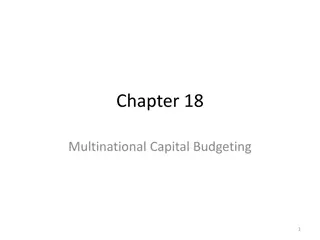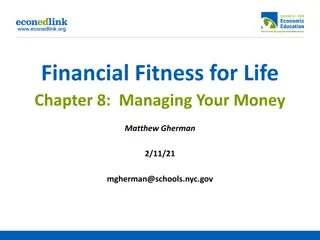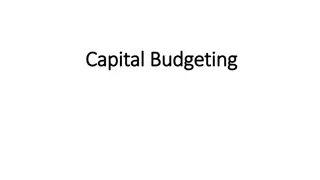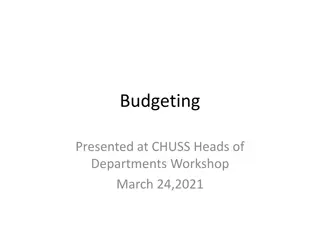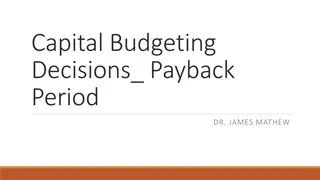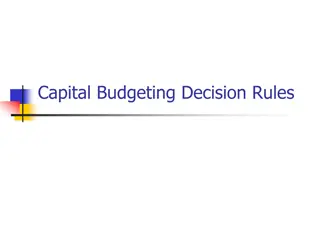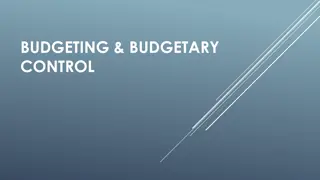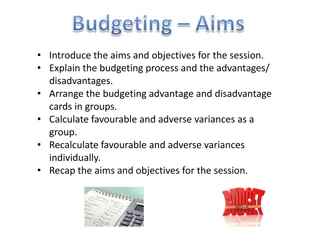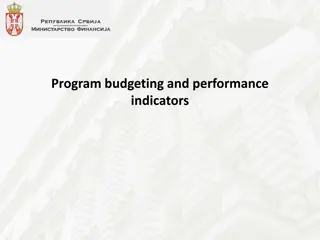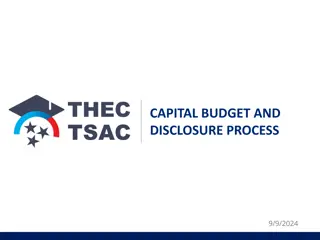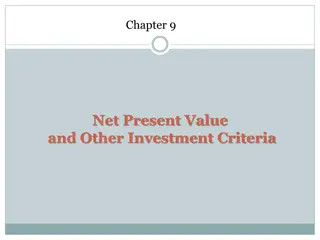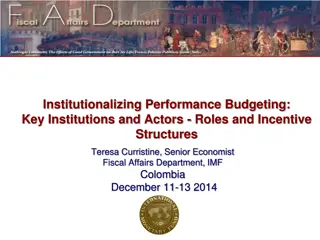Understanding Capital Budgeting Techniques and Project Evaluation
Explore the world of capital budgeting with a focus on project evaluation techniques. Learn about payback period, internal rate of return, net present value, and profitability index through a practical example of evaluating a new project for Basket Wonders. Discover how these methods can help in decision-making and selecting projects that align with financial goals.
- Capital budgeting
- Project evaluation
- Payback period
- Internal rate of return
- Financial decision-making
Download Presentation

Please find below an Image/Link to download the presentation.
The content on the website is provided AS IS for your information and personal use only. It may not be sold, licensed, or shared on other websites without obtaining consent from the author. Download presentation by click this link. If you encounter any issues during the download, it is possible that the publisher has removed the file from their server.
E N D
Presentation Transcript
Chapter 13 Capital Budgeting Techniques 13-1
Capital Budgeting Techniques Project Evaluation and Selection Potential Difficulties Capital Rationing Project Monitoring Post-Completion Audit 13-2
Project Evaluation: Alternative Methods Payback Period (PBP) Internal Rate of Return (IRR) Net Present Value (NPV) Profitability Index (PI) 13-3
Proposed Project Data Julie Miller is evaluating a new project for her firm, Basket Wonders (BW). She has determined that the after-tax cash flows for the project will be $10,000; $12,000; $15,000; $10,000; and $7,000, respectively, for each of the Years 1 through 5. The initial cash outlay will be $40,000. 13-4
Independent Project For this project, assume that it is independent of any other potential projects that Basket Wonders may undertake. Independent -- A project whose acceptance (or rejection) does not prevent the acceptance of other projects under consideration. 13-5
Payback Period (PBP) 0 1 2 3 4 5 -40 K 10 K 12 K 15 K 10 K 7 K PBP is the period of time required for the cumulative expected cash flows from an investment project to equal the initial cash outflow. 13-6
Payback Solution (#1) (a) 0 1 2 3 4 5 -40 K 10 K 12 K 15 K 10 K 7 K (-b) (d) (c) 10 K 22 K 37 K 47 K 54 K Cumulative Inflows PBP = a + ( b - c ) / d = 3 + (40 - 37) / 10 = 3 + (3) / 10 = 3.3 Years 13-7
Payback Solution (#2) 0 1 2 3 4 5 -40 K 10 K 12 K 15 K10 K 7 K -40 K -30 K -18 K -3 K 7 K 14 K PBP = 3 + ( 3K ) / 10K = 3.3 Years Cumulative Cash Flows Note: Take absolute value of last negative cumulative cash flow value. 13-8
PBP Acceptance Criterion The management of Basket Wonders has set a maximum PBP of 3.5 years for projects of this type. Should this project be accepted? Yes! The firm will receive back the initial cash outlay in less than 3.5 years. [3.3 Years < 3.5 Year Max.] 13-9
PBP Strengths and Weaknesses Strengths: Weaknesses: Easy to use and understand Can be used as a measure of liquidity Easier to forecast ST than LT flows Does not account for TVM Does not consider cash flows beyond the PBP Cutoff period is subjective 13-10
Internal Rate of Return (IRR) IRR is the discount rate that equates the present value of the future net cash flows from an investment project with the project s initial cash outflow. CF1 CF2 CFn (1+IRR)1 (1+IRR)2 (1+IRR)n ICO = + + . . . + 13-11
IRR Solution $10,000 $12,000 (1+IRR)1 (1+IRR)2 $40,000 = + + $15,000 $10,000 $7,000 + (1+IRR)3 (1+IRR)4 (1+IRR)5 + Find the interest rate (IRR) that causes the discounted cash flows to equal $40,000. 13-12
IRR Solution (Try 10%) $40,000 = $10,000(PVIF10%,1) + $12,000(PVIF10%,2) + $15,000(PVIF10%,3) + $10,000(PVIF10%,4) + $ 7,000(PVIF10%,5) $40,000 = $10,000(.909) + $12,000(.826) + $15,000(.751) + $10,000(.683) + $ 7,000(.621) $40,000 = $9,090 + $9,912 + $11,265 + $6,830 + $4,347 = $41,444 [Rate is too low!!] 13-13
IRR Solution (Try 15%) $40,000 = $10,000(PVIF15%,1) + $12,000(PVIF15%,2) + $15,000(PVIF15%,3) + $10,000(PVIF15%,4) + $ 7,000(PVIF15%,5) $40,000 = $10,000(.870) + $12,000(.756) + $15,000(.658) + $10,000(.572) + $ 7,000(.497) $40,000 = $8,700 + $9,072 + $9,870 + $5,720 + $3,479 = $36,841 [Rate is too high!!] 13-14
IRR Solution (Interpolate) .05 .10 IRR $40,000 .15 $36,841 $41,444 $1,444 X $4,603 X .05 $1,444 $4,603 = 13-15
IRR Solution (Interpolate) .05 .10 IRR $40,000 .15 $36,841 $41,444 $1,444 X $4,603 X .05 $1,444 $4,603 = 13-16
IRR Solution (Interpolate) .05 .10 IRR $40,000 .15 $36,841 $41,444 $1,444 X $4,603 ($1,444)(0.05) $4,603 X = X = .0157 IRR = .10 + .0157 = .1157 or 11.57% 13-17
IRR Acceptance Criterion The management of Basket Wonders has determined that the hurdle rate is 13% for projects of this type. Should this project be accepted? No! The firm will receive 11.57% for each dollar invested in this project at a cost of 13%. [ IRR < Hurdle Rate ] 13-18
IRR Strengths and Weaknesses Strengths: Weaknesses: Accounts for TVM Considers all cash flows Less subjectivity Assumes all cash flows reinvested at the IRR Difficulties with project rankings and Multiple IRRs 13-19
Net Present Value (NPV) NPV is the present value of an investment project s net cash flows minus the project s initial cash outflow. CF1 CF2 CFn (1+k)1 (1+k)2 (1+k)n - ICO NPV = + + . . . + 13-20
NPV Solution Basket Wonders has determined that the appropriate discount rate (k) for this project is 13%. $10,000 $12,000 $15,000 (1.13)1 (1.13)2 (1.13)3 NPV = + + + $10,000 $7,000 + (1.13)4 (1.13)5 - $40,000 13-21
NPV Solution NPV = $10,000(PVIF13%,1) + $12,000(PVIF13%,2) + $15,000(PVIF13%,3) + $10,000(PVIF13%,4) + $ 7,000(PVIF13%,5) - $40,000 NPV = $10,000(.885) + $12,000(.783) + $15,000(.693) + $10,000(.613) + $ 7,000(.543) - $40,000 NPV = $8,850 + $9,396 + $10,395 + $6,130 + $3,801 - $40,000 = - $1,428 13-22
NPV Acceptance Criterion The management of Basket Wonders has determined that the required rate is 13% for projects of this type. Should this project be accepted? No! The NPV is negative. This means that the project is reducing shareholder wealth. [Reject as NPV < 0 ] 13-23
NPV Strengths and Weaknesses Weaknesses: Strengths: May not include managerial options embedded in the project. See Chapter 14. Cash flows assumed to be reinvested at the hurdle rate. Accounts for TVM. Considers all cash flows. 13-24
Net Present Value Profile $000s 15 Plot NPV for each discount rate. Sum of CF s Net Present Value 10 5 IRR NPV@13% 0 -4 0 3 6 9 12 15 Discount Rate (%) 13-25
Profitability Index (PI) PI is the ratio of the present value of a project s future net cash flows to the project s initial cash outflow. CF1 CF2 CFn (1+k)1 (1+k)2 (1+k)n PI = ICO + + . . . + << OR >> PI = 1 + [ NPV / ICO ] 13-26
PI Acceptance Criterion PI = $38,572 / $40,000 = .9643 (Method #1, 13-33) Should this project be accepted? No! The PI is less than 1.00. This means that the project is not profitable. [Reject as PI < 1.00 ] 13-27
PI Strengths and Weaknesses Strengths: Weaknesses: Same as NPV Allows comparison of different scale projects Same as NPV Provides only relative profitability Potential Ranking Problems 13-28
Evaluation Summary Basket Wonders Independent Project Method Project Comparison Decision PBP 3.3 IRR 11.47% NPV -$1,424 PI .96 3.5 13% $0 1.00 Accept Reject Reject Reject 13-29
Other Project Relationships Dependent -- A project whose acceptance depends on the acceptance of one or more other projects. Mutually Exclusive -- A project whose acceptance precludes the acceptance of one or more alternative projects. 13-30
Potential Problems Under Mutual Exclusivity Ranking of project proposals may create contradictory results. A. Scale of Investment B. Cash-flow Pattern C. Project Life 13-31
A. Scale Differences Compare a small (S) and a large (L) project. NET CASH FLOWS Project S Project L END OF YEAR 0 -$100 -$100,000 1 0 0 2 $400 $156,250 13-32
Scale Differences Calculate the PBP, IRR, NPV@10%, and PI@10%. Which project is preferred? Why? Project IRR NPV PI S L 25% $29,132 1.29 100% $ 231 3.31 13-33
B. Cash Flow Pattern Let us compare a decreasing cash-flow (D) project and an increasing cash-flow (I) project. NET CASH FLOWS Project D Project I END OF YEAR 0 -$1,200 -$1,200 1 1,000 100 2 500 600 3 100 1,080 13-34
Cash Flow Pattern Calculate the IRR, NPV@10%, and PI@10%. Which project is preferred? Project IRR NPV PI ? ? D 23% $198 1.17 I 17% $198 1.17 13-35
Examine NPV Profiles Plot NPV for each project at various discount rates. -200 0 200 400 600 Net Present Value ($) NPV@10% IRR 0 5 10 15 20 25 Discount Rate (%) 13-36
Fishers Rate of Intersection -200 0 200 400 600 Net Present Value ($) At k<10%, I is best! Fisher s Rate of Intersection At k>10%, D is best! 0 5 10 15 20 25 Discount Rate ($) 13-37
C. Project Life Differences Let us compare a long life (X) project and a short life (Y) project. NET CASH FLOWS Project X Project Y END OF YEAR 0 -$1,000 -$1,000 1 0 2,000 2 0 0 3 3,375 0 13-38
Project Life Differences Calculate the PBP, IRR, NPV@10%, and PI@10%. Which project is preferred? Why? Project IRR NPV PI ? ? X 50% $1,536 2.54 Y 100% $ 818 1.82 13-39
Another Way to Look at Things 1. Adjust cash flows to a common terminal year if project Y will NOT be replaced. Compound Project Y, Year 1 @10% for 2 years. Year 0 1 2 3 CF -$1,000 $0 $0 $2,420 Results: IRR* = 34.26% NPV = $818 *Lower IRR from adjusted cash-flow stream. X is still Best. 13-40
Replacing Projects with Identical Projects 2. Use Replacement Chain Approach (Appendix B) when project Y will be replaced. 0 1 2 3 -$1,000 $2,000 -1,000 $2,000 -1,000 $2,000 -$1,000 $1,000 $1,000 $2,000 Results: *Higher NPV, but the same IRR. Y is Best. IRR* = 100% NPV* = $2,238.17 13-41
Capital Rationing Capital Rationing occurs when a constraint (or budget ceiling) is placed on the total size of capital expenditures during a particular period. Example: Julie Miller must determine what investment opportunities to undertake for Basket Wonders (BW). She is limited to a maximum expenditure of $32,500 only for this capital budgeting period. 13-42
Available Projects for BW Project ICO IRR NPV PI A $ 500 18% $ 50 1.10 B 5,000 25 C 5,000 37 D 7,500 20 E 12,500 26 F 15,000 28 21,000 2.40 G 17,500 19 H 25,000 15 6,500 2.30 5,500 2.10 5,000 1.67 500 1.04 7,500 1.43 6,000 1.24 13-43
Choosing by IRRs for BW Project ICO IRR NPV PI C $ 5,000 37% $ 5,500 2.10 F 15,000 28 E 12,500 26 B 5,000 25 Projects C, F, and E have the three largest IRRs. The resulting increase in shareholder wealth is $27,000 with a $32,500 outlay. 21,000 2.40 500 1.04 6,500 2.30 13-44
Choosing by NPVs for BW Project ICO IRR NPV PI F $15,000 G 17,500 B 5,000 Projects F and G have the two largest NPVs. 28% $21,000 2.40 19 7,500 1.43 25 6,500 2.30 The resulting increase in shareholder wealth is $28,500 with a $32,500 outlay. 13-45
Choosing by PIs for BW Project ICO IRR NPV PI F B C D G $15,000 5,000 5,000 7,500 17,500 28% 25 37 20 19 $21,000 2.40 6,500 2.30 5,500 2.10 5,000 1.67 7,500 1.43 Projects F, B, C, and D have the four largest PIs. The resulting increase in shareholder wealth is $38,000 with a $32,500 outlay. 13-46
Summary of Comparison Method Projects Accepted Value Added PI F, B, C, and D $38,000 NPV F and G $28,500 IRR C, F, and E $27,000 PI generates the greatestincrease in shareholder wealth when a limited capital budget exists for a single period. 13-47
Post-Completion Audit Post-completion Audit A formal comparison of the actual costs and benefits of a project with original estimates. Identify any project weaknesses Develop a possible set of corrective actions Provide appropriate feedback Result: Making better future decisions! 13-48




